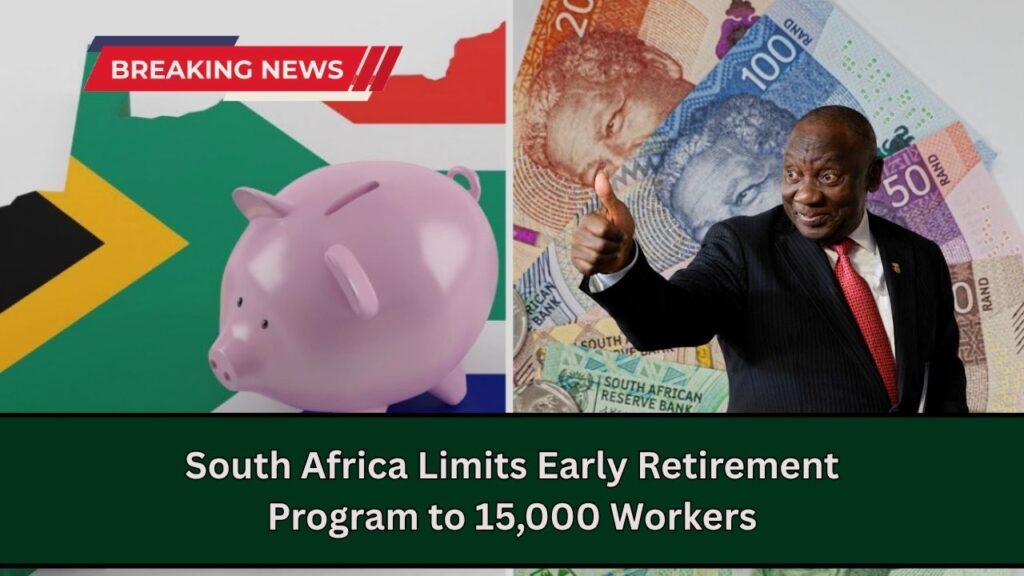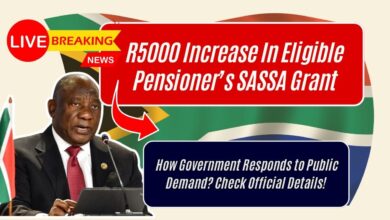South Africa Limits Early Retirement Program to 15,000 Workers — What You Need to Know?
South Africa Limits Early Retirement Program – South Africa has taken a bold step by limiting its early retirement program to 15,000 public sector employees, aiming to cut government wage costs and create new job opportunities for younger workers. Rolling out over the 2025/26 and 2026/27 fiscal years, this move could reshape the public workforce—but it also raises questions for employees, taxpayers, and the nation. If you’re wondering what this program is all about, who qualifies, and what it means for you or the country, this article breaks down everything from the basics to the nitty-gritty.

South Africa Limits Early Retirement Program
| Feature | Details |
|---|---|
| Program Limit | Early retirement capped at 15,000 public sector employees |
| Eligible Age Range | Employees aged 55 to 63 years |
| Budget Allocation | R4 billion earmarked for the program over two fiscal years (2025/26 & 2026/27) |
| Pension Benefits | Early retirees eligible without reduction in pension benefits, if criteria are met |
| Objectives | Reduce government wage bill, create youth employment opportunities, retain key skills |
| Labor Union Reaction | Opposition citing concerns over service delivery and job security |
| Implementation Timeline | Program active during the 2025/26 and 2026/27 financial years |
| Official Reference | South African Government Budget Review |
South Africa’s early retirement program capped at 15,000 workers represents a pragmatic effort to reduce government expenses and refresh the public sector workforce. It balances financial necessity with social responsibility, opening doors for youth while providing fair retirement options for older employees. However, the success of this initiative hinges on effective planning, communication, and support to minimize disruptions.
If you’re a public servant, financial advisor, or policymaker, understanding these nuances is critical to making informed decisions as this program unfolds.
Why Now? The Historical Context Behind the Program
South Africa’s public sector wage bill has ballooned over the years, making up a significant portion of government expenditure—over 40% of total national revenue in some recent years. This puts pressure on budgets for social services, infrastructure, and economic development. Additionally, the country faces one of the highest youth unemployment rates globally, hovering near 46.5% for ages 15 to 34 (Stats SA, 2023).
Past attempts to control government spending included freezing hiring and freezing salaries, but these have only provided temporary relief. The early retirement program is a more targeted solution—designed to strategically reduce the payroll by encouraging older workers to exit, while hiring younger workers to fill the gaps.
How South Africa’s Program Compares Globally?
Looking across the pond, the United States also uses early retirement incentives in the public sector, but often with different age brackets and pension rules. For example, many US government employees can retire with full benefits at age 57 with at least 30 years of service, or at 62 with five years of service. Unlike South Africa’s cap on numbers, many US programs are open-ended but constrained by budget availability.
South Africa’s move to limit retirements to 15,000 workers is somewhat unique, reflecting tighter fiscal discipline and a focus on balancing cost savings with workforce stability.
Deep Dive: Financial Impact and What It Means for Taxpayers
The government has earmarked R4 billion (~$240 million USD) for this program over two years. This money goes toward paying pension benefits of early retirees without penalizing them for retiring early, a cost that would normally hit the government’s books hard.
By contrast, reducing the wage bill by cutting salary expenses for these workers over several years could save the government significantly more. These savings can be redirected to other pressing needs like healthcare, education, or economic stimulus programs, which benefit taxpayers and citizens alike.
However, these savings depend on how effectively the government fills vacant positions with younger employees at lower wages or restructures roles.
Risks and How the Government Plans to Manage Them?
The plan isn’t without challenges:
- Loss of Experience: The retirement of thousands of seasoned workers risks a knowledge gap.
- Service Disruptions: Critical departments like health and police already face staff shortages.
- Labor Opposition: Unions worry about job losses and impact on livelihoods.
To mitigate these, the government is working on:
- Phased retirements to avoid sudden workforce gaps.
- Investing in training and mentoring programs for new hires.
- Engaging with unions to ease concerns and improve communication.
A Day in the Life: Hypothetical Employee Scenarios
Let’s meet Thabo, a 58-year-old public health nurse who’s worked for 30 years. With the new program, Thabo can retire early and still receive full pension benefits. He’s excited to spend more time with his family but worries about replacing his role in a busy clinic.
Meanwhile, Naledi, 30, has struggled to find a stable job since graduating. Thabo’s early retirement opens a spot for her in the public sector, giving her a chance to build her career and support her community.
Legal and Policy Framework
The early retirement program is backed by amendments in South African labor laws and pension regulations. It aligns with the Public Service Act and Pension Funds Act, ensuring it’s administered fairly and transparently under government oversight.
What Should Public Servants Do Next? A Practical Guide
Step 1: Confirm Eligibility
Visit your HR department or official government websites to check if you qualify based on age and service.
Step 2: Review Pension Details
Consult with pension fund administrators or financial advisors to understand the impact on your retirement income.
Step 3: Consider Your Options
Think about your personal and financial readiness to retire early.
Step 4: Prepare Documentation
Gather necessary documents such as service records and identification for the application process.
Step 5: Submit Your Application
Follow official guidelines for applying within deadlines.
Step 6: Plan Your Transition
Coordinate with supervisors for smooth handover and exit procedures.
South Africa Driving License 2025 Overhaul – Digital Licenses & 8-Year Validity Coming!
SASSA Confirms Old Age Grant Increase for 2025 — Check How Much You Can Get!
SASSA’s R2,090 Grant in 2025: When You’ll Be Paid, Who Qualifies, and What’s Changing
FAQs About South Africa Limits Early Retirement Program
Q1: Who qualifies for early retirement under this program?
A1: Public sector employees aged 55 to 63 years who meet service and other criteria.
Q2: Will early retirement reduce my pension benefits?
A2: No, eligible employees can retire without pension penalties under this scheme.
Q3: How many workers can retire early?
A3: Up to 15,000 employees during the 2025/26 and 2026/27 financial years.
Q4: Can I keep working after early retirement?
A4: Some may work part-time or contractually, but it depends on government policy.
Q5: Where can I get help applying?
A5: Contact your HR office or visit official government websites like the South African Government Budget Review.







